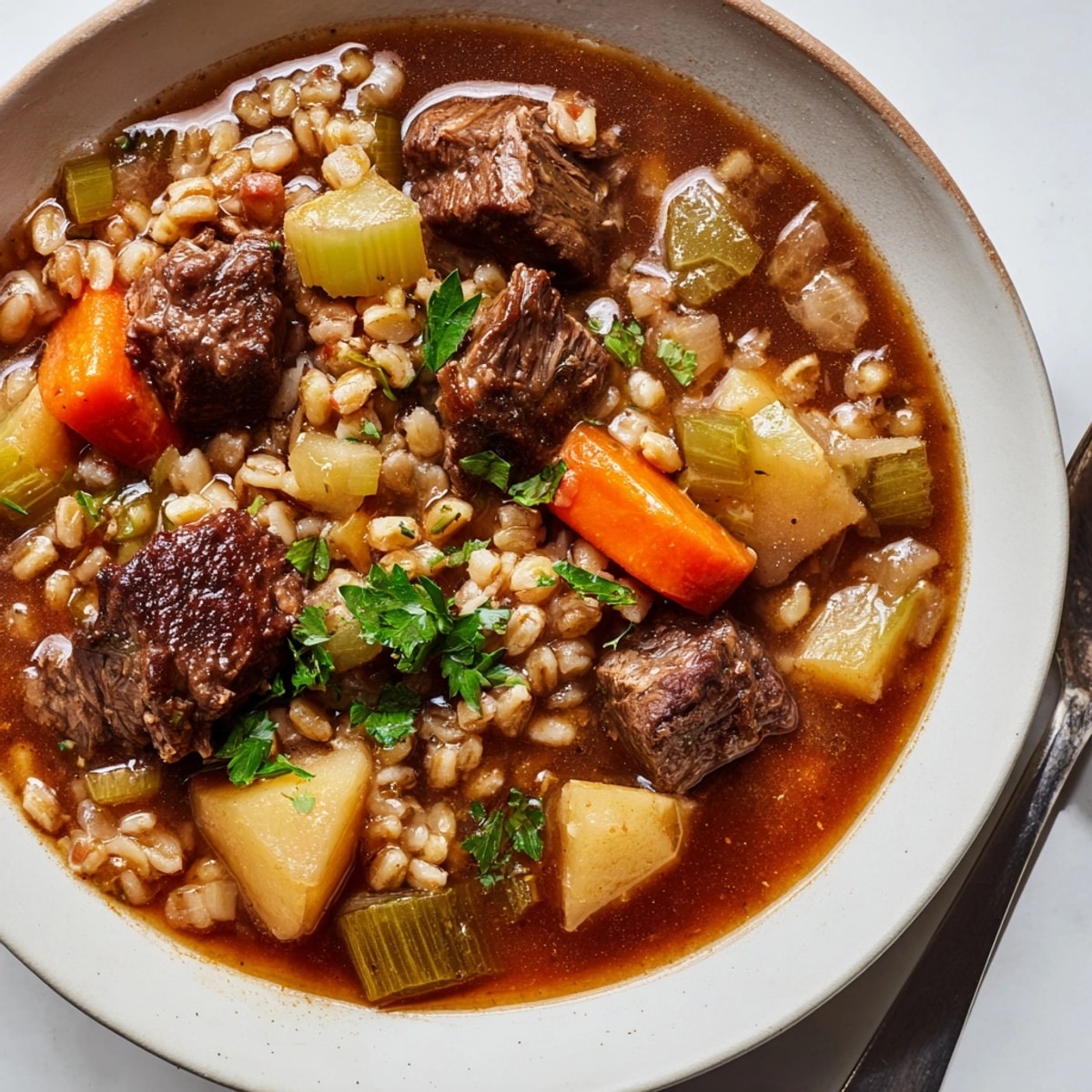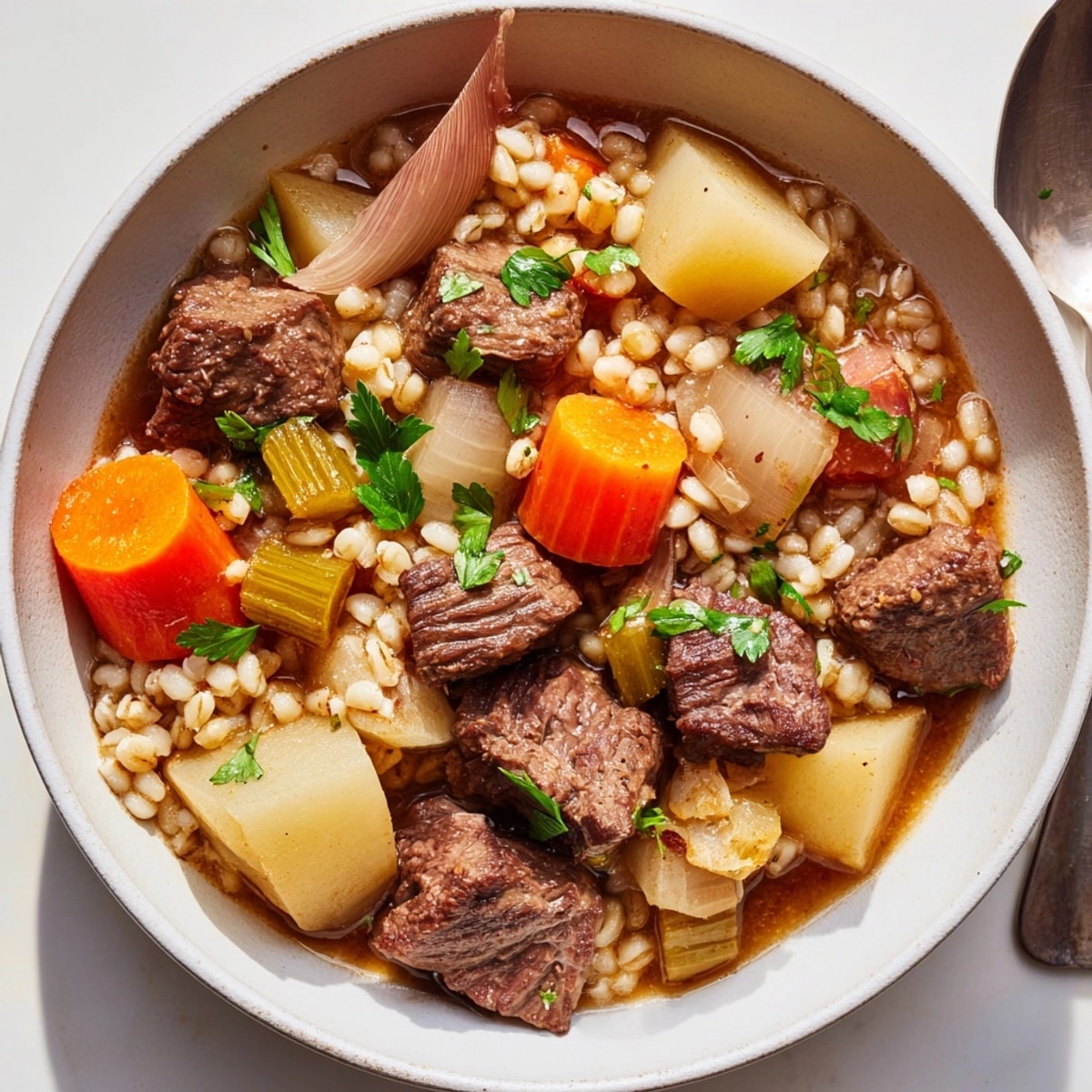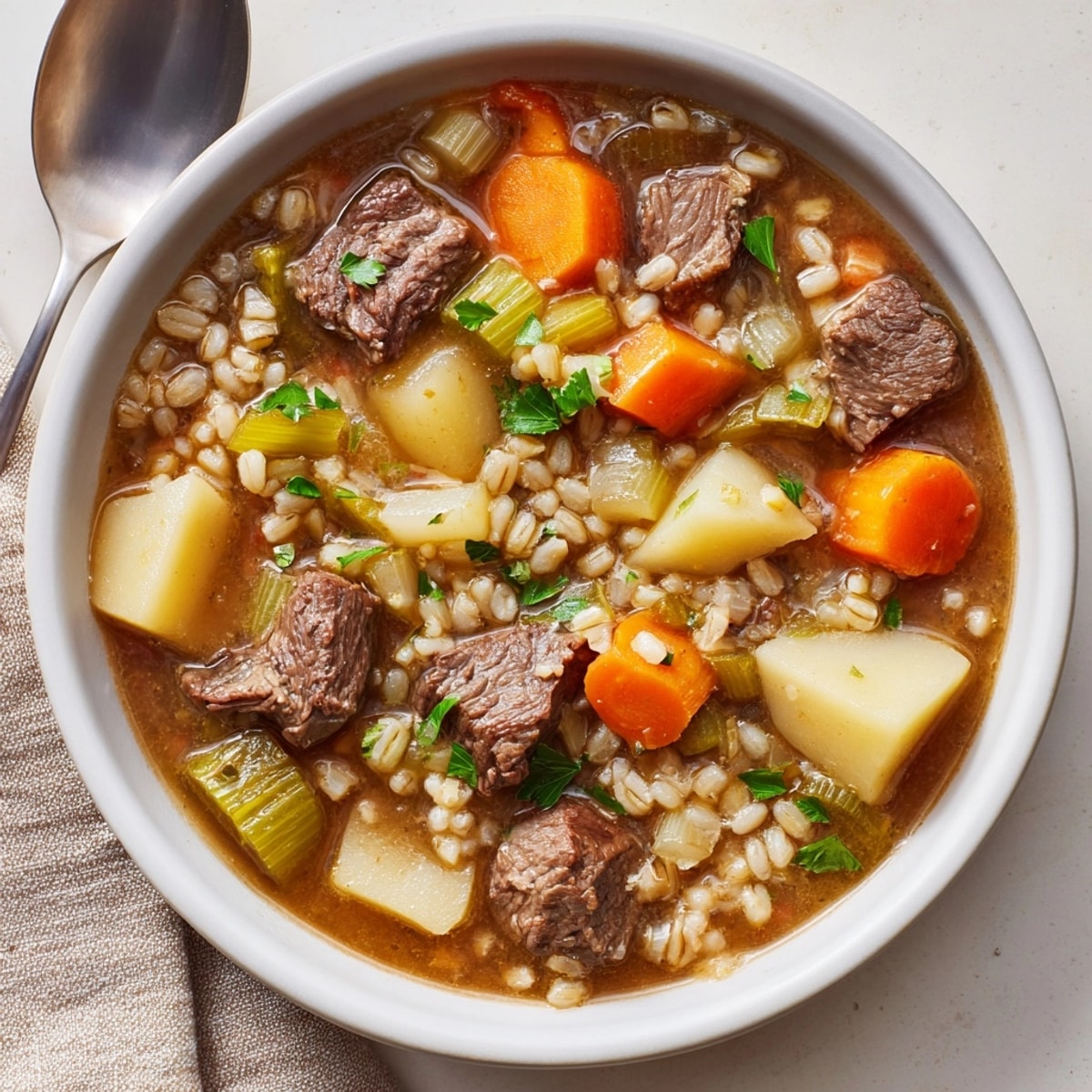 Save
Save This beef and barley stew with root vegetables is my answer to a bone-deep winter chill. Every spoonful balances nutty barley, succulent chunks of beef, and a rainbow of caramelized root vegetables in an herby, warming broth. It is my hearty go-to whenever the family gathers on a cold night and the aroma alone brings everyone to the kitchen before it is even ready.
I first made this stew for a snowed-in weekend with friends and it quickly became a tradition. The slow simmer transforms basic ingredients into pure comfort
Ingredients
- Beef chuck cubes: offer rich marbling that melts into fork-tender bites. Look for well-trimmed beef with a bit of visible fat
- Olive oil: brings a subtle floral note to browning. Skip vegetable oils for a cleaner taste
- Salt and freshly ground black pepper: help amplify beefy flavors. Use flaky salt if you have it
- Carrots, parsnips, celery, onion, potatoes, optional turnip: provide natural sweetness and body. Choose firm vegetables without soft spots or blemishes
- Garlic: gives earthy depth. Freshly minced for the brightest flavor
- Pearl barley: lends a nutty chewy texture and thickens the broth. Opt for plump even pearls without debris
- Low-sodium beef broth: sets the stew’s savory base so you can control seasoning. Choose one with clean ingredients or homemade if possible
- Tomato paste: adds a gentle tang and deep red hue. Go for double-concentrated if available
- Bay leaves, dried thyme, dried rosemary: infuse subtle herbiness. Use dried herbs for a slow-cooked dish like this
- Fresh parsley: brightens the finished bowls. Snip just before serving for a burst of color
Instructions
- Sauté the Beef:
- Pat the beef cubes dry and season all over with salt and pepper. Heat the olive oil in a large Dutch oven over medium-high. Get the pot really hot before adding beef. Sear the cubes in batches without crowding. Turn with tongs until well-browned on all sides, about 3 to 4 minutes per batch. Transfer browned beef to a plate while you finish the rest. This careful browning is where your stew’s rich flavor begins
- Cook the Vegetables:
- Keep the same pot on medium heat and add the onion, carrots, parsnips, celery, potatoes, and turnip if using. Stir often for about 5 minutes as the vegetables soften and pick up beefy bits from the pan bottom. The goal is to let them get glossy and just a hint golden around the edges
- Bloom the Garlic:
- Add the minced garlic to the softened veggies. Stir constantly for 1 full minute until the room smells fragrant. Watch closely and do not let the garlic burn
- Toast the Tomato Paste:
- Spoon in the tomato paste. Smear it all over the vegetables and cook for another full minute. The paste will darken slightly and stick to the bottom. This step boosts the broth’s color and depth
- Combine and Simmer:
- Return the browned beef with any juices to the pot. Add rinsed barley, beef broth, water, bay leaves, thyme, and rosemary. Stir to combine. Raise the heat to bring everything to a rolling boil. Scrape any fond from the bottom of the pot as you go
- Slow Cook:
- Reduce the heat to low. Cover the pot and let the stew simmer gently for ninety minutes to two hours. Stir every twenty minutes making sure nothing sticks to the bottom. You want the beef fork-tender and the barley plump. Taste the broth toward the last half hour. If it looks too thick add a splash of water
- Finish and Serve:
- Fish out the bay leaves. Adjust seasoning with more salt and pepper to taste. Ladle into warm bowls. Sprinkle generously with chopped parsley. Serve piping hot with crusty bread or on its own for a filling meal
 Save
Save My favorite ingredient in this stew is the parsnip. It has a mellow sweetness that pairs perfectly with the beef. My grandmother used to sneak an extra handful into her pot and I still do the same. It always brings back cozy memories shared around her kitchen table
Storing Your Stew
Let leftovers cool completely before transferring to airtight containers. You can refrigerate for up to four days. If the stew thickens after chilling just add a splash of broth or water when reheating. Gently reheat over low to prevent the beef and barley from breaking down
Swapping Ingredients
If you are short on parsnips or turnip simply double the carrots or potatoes. For a gluten-free version try cooked brown rice or quinoa instead of barley. Reduce simmering time if you make this swap. If you want to boost the savoriness a splash of red wine is magic right after browning the beef
Serving Suggestions
I love to pair this stew with a chunk of rustic bread or a lightly dressed green salad. For extra richness a dollop of dairy-free yogurt stirred on top is wonderful. My family also enjoys it poured over creamy mashed potatoes for a stick-to-your-ribs meal
A Peek into Tradition
Stews like this are classic cold-climate fare in American kitchens stretching back generations. The recipe evolved from resourcefulness: using every bit of root vegetable and meat to feed a crowd during winter months. Barley stews can be found in European and American cooking traditions for the same reason. They make humble ingredients into something truly special
Adapting to the Season
Use sweet potatoes or rutabagas in autumn months for a deeper flavor. In late winter add diced celery root for an earthy twist. Choose whatever root veggies look freshest at your market. I always make this with whatever root vegetables look the best that week. The mix changes but the soul of the dish always remains
Success Stories
This stew is my go-to for potlucks and family reunions. I have had so many friends beg for the recipe after just one bowl. The leftovers freeze beautifully and are lifesavers for weeknight meals. Sometimes I even split a batch and freeze half just for those busy days
Freezer Meal Magic
Ladle fully cooked stew into freezer containers and cool completely before freezing. It keeps well for up to three months. Thaw overnight in the fridge then reheat gently on the stovetop. The texture of barley makes this one of the few stews that is just as good after freezing as fresh
 Save
Save This meal is the definition of hearty home cooking. It is a recipe I revisit every winter and every time I do it brings new memories and plenty of second helpings
Recipe FAQs
- → What cut of beef is best for this stew?
Beef chuck is recommended for its tenderness and flavor after slow simmering.
- → Can I substitute barley with another grain?
Brown rice or quinoa are great gluten-free alternatives; be sure to adjust cook time accordingly.
- → How can I enhance the richness of the broth?
Add a splash of red wine after browning the beef for deeper, more robust flavor.
- → Is it possible to swap vegetables?
Yes, you can use rutabaga, sweet potatoes, or other root vegetables based on preference.
- → What garnish works well with this stew?
Chopped fresh parsley adds color and freshness; additional herbs may be used if desired.
- → How can I make this dairy-free?
This dish is naturally dairy-free when prepared as described in the instructions.